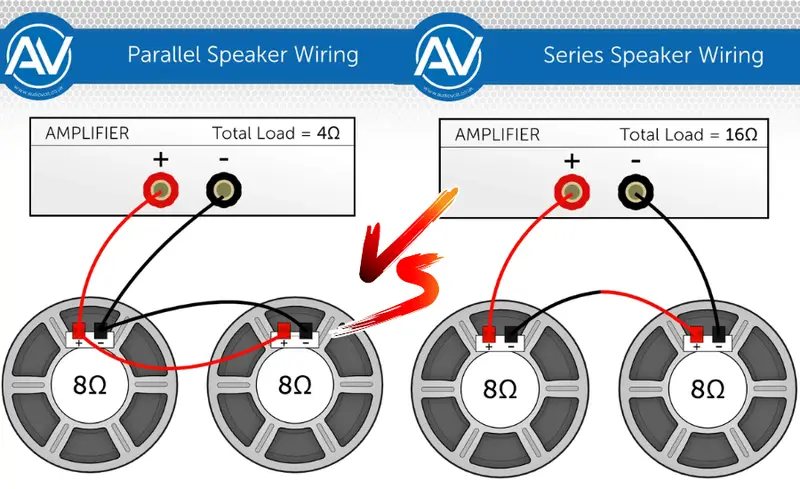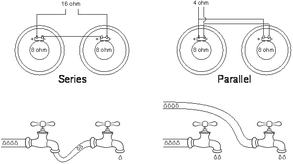Last Updated on 6 months by On Trends Gear
A variety of techniques exist for wiring speakers. The most common wiring configurations are Series vs Parallel Speaker Wiring, and each has different effects on the speaker’s sound and functionality.
Speakers should be wired in parallel for optimum sound quality. This is because the sound quality achieved through parallel wiring is often better than that achieved through series wiring.
This technique allows the individual crossover to be optimized for performance by limiting its exposure to the resonant frequencies of only one speaker.
But there’s more to learn about this subject than you would expect. In some cases, connecting your speakers in a series may be the most effective method of achieving your objectives.
This in-depth guide will teach you all you need to know about Series vs Parallel Speaker Wiring, including how it works and also the difference between the two.
Table of Contents
How do Series Speakers Work?
Speaker terminals allow series speakers to be linked to other series speakers. Speakers are linked together using audio power amplifiers, and the audio signal is sent from one speaker to the next through speaker cables.
These connections can be wired or wireless, allowing for relatively complicated configurations to be achieved without the need for extensive use of stringing cables.
When the crossover frequency varies from one speaker to the next, unwanted sounds might go from one speaker to the next.
As a result, the future speaker may encounter more opposition. As a result, your audio system will continue to experience an uneven load, which will result in distorted audio.
How Parallel Speakers Work?
It is not difficult to establish a connection between parallel speakers. Each speaker’s positive terminal is connected to the other’s negative terminal, and vice versa.
To prevent a possible short circuit, you should not run your power lines in parallel.
When using parallel speakers, there is no crossover shift. When a crossover is used, the resistance of just one speaker is checked.
This suggests that each speaker has improved frequency-selective filtering, leading to less distortion.
Differences Between Series vs Parallel Speaker Wiring
Speakers can be wired in either a parallel circuit or a series circuit. Both of these Series vs Parallel Speaker Wiring work, but there are important distinctions between them.
Before diving into the key distinctions, it’s important to note that parallel wiring for speakers is typically preferable to series wiring.
This is because the performance and sound quality of devices with parallel wiring are often higher in quality and more dependable.
However, there are a few edge cases where series wiring may be better than parallel wiring for certain speakers.
The problem is that series wiring is not reliable and might cause undesired sounds to be output from the speakers.

| Parallel Speaker Wiring | Series Speakers Wiring |
| Because of its simplicity, parallel speaker wiring has become the standard. Connecting the positive and negative cables is the first step. Each speaker’s connections can be linked together or connected to a single amplifier terminal to create any of these permutations. This eliminates the requirement for a return cable connecting the speaker to the amplifier. | However, there are some additional difficulties with series wiring. Swap the negative terminals of each pair of speakers if your audio system has more than two. If you trace a speaker circuit backwards from the final speaker, you’ll find that it returns the negative lead to the amplifier. There will be a positive lead coming from the first amplifier in the chain and a negative lead coming from the last speaker; these must be linked to the amplifier. |
| When speakers are wired in parallel, only the proper resistance of one speaker is seen by the crossovers. | On the other hand, the crossover is vulnerable to changed Ohms when wired in series. In some cases, this might make it more challenging to control the sound’s volume and quality. |
| Sounds produced by parallel speaker wirings are uniform. | nonetheless, series wiring is not always preferred due to its “weird” or “unattractive” sound |
How Does Wiring Affect Volume?
Once you have your head around series and parallel wiring, you should find this to be rather straightforward to grasp.
Parallel wiring, as previously mentioned, offers significantly lower resistance than series wiring. Because resistance lowers voltage, which in turn lowers volume, increasing resistance reduces the output volume of a circuit.

To further understand this, one may imagine light bulbs being used instead of speakers. Envision a setup where three lights are connected to the same power source in a series.
Connect the amplifier to the first bulb, then the second, and so on, until you reach the amplifier again. Since the bulbs in this circuit are effectively sharing the voltage when it is turned on, the light output is quite low.
Parallel wiring is analogous to connecting individual light bulbs to separate circuits, each of which is then connected to the amplifier.
Each bulb would be wired to its separate circuit, which would supply full current and also be connected to a separate circuit.
One amp will power the whole circuit, allowing each bulb to emit as much light as its current allows.
This is directly applicable to speaker installation. If you connect your speakers in series, the current through each will be reduced because each speaker will be sharing the same circuit.
In a parallel speaker setup, all of the speakers share the same channel and get full power from the amplifier, therefore the sound is unaffected by resistance to the flow of current.
The concept of impedance stems from this phenomenon. One way to determine the level of resistance in a circuit is by measuring its impedance.
Impedance increases in a series circuit compared to a parallel one.
Because of this, the impedance of a series circuit is higher, resulting in lower volume, whereas the impedance of a parallel circuit is lower, resulting in more volume.
Are Speakers Louder In Parallel Or Series?
Here are some of the reasons why parallel speakers tend to be louder than series ones:
- Increasing the overall impedance (Ohms) load of the speakers by wiring them in series reduces the amount of electrical current (amps) that can flow through the system. The volume level of the amplifier or audio system will therefore be reduced.
- Speakers connected in series only get a portion of the power, thus they won’t be pushed as hard as those connected in parallel.
This is a common scenario that calls for speakers designed for an amplifier or stereo. Using speakers with a lower impedance on purpose to reduce the overall speaker load is an exception.
Conclusion
With your newfound knowledge of Series vs Parallel Speaker Wiring, what do you think is best? Which method of wiring, parallel or series, will you be using?
Speaker output from series wiring is high in the midrange and more durable, although most people choose parallel because the sound is better owing to reduced resistance.
Parallel wiring is your go-to option if you enjoy low frequencies. In addition, you may improve the sound quality by combining the two.
Top Rated Home Audio Speakers You Should Buy
Last update on 2024-07-27 / Affiliate links / Images from Amazon Product Advertising API




